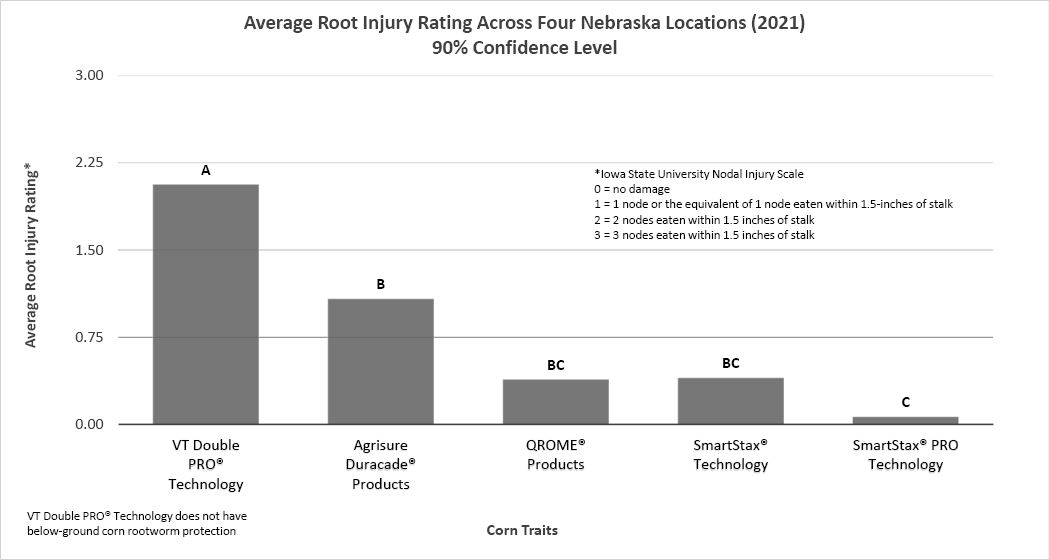5 MIN READ
Evaluation of Corn Rootworm Management in Nebraska
February 3, 2022
TRIAL OBJECTIVE
Evaluate the relative performance of commercially available, below-ground traits for corn rootworm protection.
Demonstrate the value of below-ground, corn rootworm protection for reducing the potential of root damage.
Highlight the improved corn rootworm control of trait platforms with multiple modes of action.
RESEARCH SITE DETAILS
- This single replication strip trial was conducted across four locations during the 2021 growing season.
- Sites were selected for a history of corn rootworm damage and typical planting dates for the area were targeted.
- Each location planted locally adapted corn products with relative maturities of 104 to 113 days. The corn product genetics varied by available trait.
- Below-ground corn rootworm protection traits in the trial were:
- SmartStax® PRO Technology
- SmartStax® Technology
- Agrisure Duracade® Products
- Qrome® Products
- VT Double PRO® Corn, which does not have below-ground corn rootworm protection, was used as a check.
- Below-ground corn rootworm protection traits in the trial were:
- 10 consecutive plants from each entry in representative areas of the plot were collected at the R1 growth stage and assigned a root damage rating using the Iowa State Nodal Injury Scale (NIS03).
- NIS03 has a 0 to 3 scale
- 0 = No Damage
- 1 = 1 node or the equivalent of 1 node eaten within 1.5-inches of stalk
- 2 = 2 nodes eaten within 1.5-inches of stalk
- 3 = 3 nodes eaten within 1.5-inches of stalk
- NIS03 has a 0 to 3 scale
- A multi-trait corn leaf field test was performed on all samples to verify the presence of specific traits and to avoid any refuge plants biasing the data. All refuge plants were excluded from the data and an average NIS 0-3 was calculated for each entry based on the traited plants.
- Weeds were controlled uniformly across the study with no insecticides or fungicides being applied. Nutrient management was managed by the landowners according to their agronomic plan.
- % Stalk Lodging, % Root Lodging, Yield, and % Moisture observations were collected at each location along with NIS 0-3.

UNDERSTANDING THE RESULTS

The average NIS 0-3 score across the four locations shows a statistically significant reduction in root feeding between products with VT Double PRO® Technology (that contain no below-ground protection) and the products that contain a below-ground trait (Figure 1).
The average NIS 0-3 score across the four locations for SmartStax® PRO technology products was significantly lower than the Agrisure Duracade® products. Although not statistically significant, the NIS03 score for SmartStax® PRO technology products trended lower than the SmartStax® corn and Qrome® Products scores.
KEY LEARNINGS
- This study illustrates that in a field with a history of corn rootworm pressure, planting a product with below-ground rootworm protection with multiple modes of action can significantly reduce the observed root feeding compared to a product with no below-ground trait for corn rootworm protection.
- SmartStax® PRO technology is the only trait platform tested that has below-ground insect protection with three modes of action. It did not statistically separate itself from the other below-ground trait platforms; however, its NIS03 score consistently trended better. Please reach out to your local agronomist for further insights.
- Management of corn rootworm requires a holistic approach that focuses on monitoring the life cycle and prevalence of the pest to determine the best pest control methods for the current and future growing seasons. Prior agronomic practices, like planting corn-on-corn, can create higher pest pressure than in rotated fields.
- Maintaining sound agronomic practices and planting corn products with corn traits that defend against corn rootworm should help provide the greatest protection to help preserve corn yield potential.
1001_R2_21
Seed Brands & Traits
Crop Protection
Disclaimer
Always read and follow pesticide label directions, insect resistance management requirements (where applicable), and grain marketing and all other stewardship practices.
©2024 Bayer Group. All rights reserved.